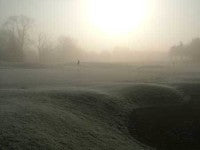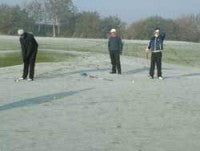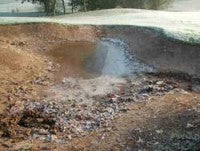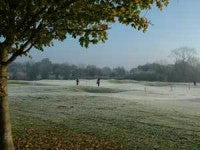Frosty Golf-What's your view?
Frosty Golf
By Laurence Gale MSc

How many golf courses allow play on their greens during frosty conditions? Ideally none, however there are many golf clubs who unfortunately do. WHY?
There may be several reasons :-
- Player Pressure?
- No closed course policy?
- Have no temporary greens?
- Lack of understanding of what harm can occur to the turf from frost damage.
- Revenue Needs
Many club members expect to be able to play the greens all year round. Once they have booked a game, they expect to play whatever the weather. Many courses do not implement a closed course policy, or maybe just need to keep the course open for financial reasons.
Damage to the Greens

|

|
Turf is especially prone to damage when it is frozen or when the ground is thawing. Normal practice is for a course to remain closed until the ground has completely thawed, which often occurs by mid morning.
What happens to turf in frost conditions?
Frost on the grass leaf blades tells us that the water inside the leaves is frozen. Remember that 80+% of plant tissue is made up of water, the primary component of plant tissue. When this water is frozen, foot traffic on the turf causes the ice crystals in the cells to puncture through the plant's cell walls, thus killing plant tissue.
When they are frozen the leaves of the turf get easily bruised by player's feet. After thawing, the affected turf turns black or brown and becomes sparse. The turf can often remain thin for long periods if damage occurs early in the winter. The fine turf on greens becomes more susceptible to disease and the putting surface becomes very uneven.
More long-term damage can be caused when play takes place as the turf is thawing after a prolonged freeze. Under these conditions the top surface of the turf may be soft, but the underlying soil can still be frozen. Root damage occurs easily from a shearing action as player's feet move the soft top surface against the frozen sub soil.
The process of damage to the turf normally occurs in the following pattern:
- Bruising and damage to the leaf.
- Loss of turf colour.
- Severing of grass roots.
- Compaction of the soil.
- Thinning of the swards.
Each time you continue to allow play on frosty greens you continue to promote further turf decline. Low soil and air temperatures prevent turfgrass recovery.
However, many golf clubs do operate a favourable frost policy, whereby a number of contingencies are put in place to reduce frost damage on the course and allow golf to be played during frosty conditions, some of the methods used by clubs include:
- Many clubs are now using artificial winter tee mats, which are brought out for the winter period.
- Temporary green areas have been mown out and introduced for winter play.
- The course is inspected every morning by the greenkeeping staff who then make a judgement on whether the greens / or which greens are playable depending on the severity of the frost.
Often if the frost is a haw frost, it is likely that many of the greens will be playable by late morning once thawed. In most cases frost damage will not be noticeable until the spring when long term damage has already occurred. A poor thin sward, a heavy compacted green and a poor putting surface are all consequences of play being allowed on frosty courses.
The best policy is for a club to inform club members / players of the reasons why greens and courses must be closed during heavy frosts. Explaining these facts to the members and players will help them understand the longer term benefits of maintaining the sward quality of their greens.
What is your Golf Clubs policy on playing during Frost?
Please let us know with comments below, also why do Golf Clubs not use frost protection covers on their more exposed greens?
